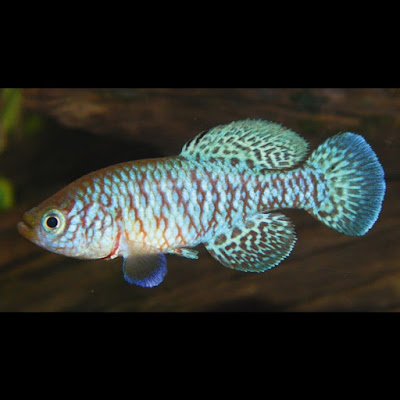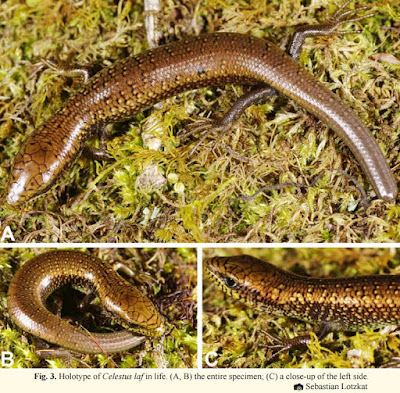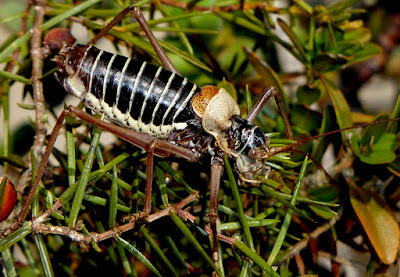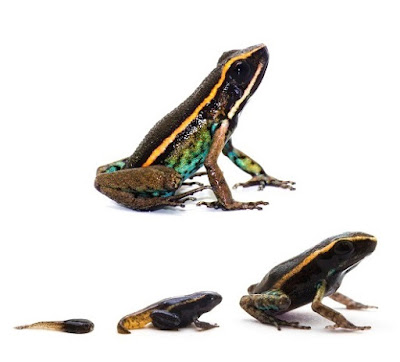[Most Recent Entries] [Calendar View]
Monday, January 16th, 2017
| Time | Event | ||||
| 1:00a | [Ichthyology • 2014] Nothobranchius chochamandai • A New Species of Annual Killifish (Cyprinodontiformes: Nothobranchiidae) from the Luapula drainage, Democratic Republic of Congo Nothobranchius chochamandai, new species, is described from ephemeral swamps of the Kinikabwimba River, tributary of Lufutishi River in the lower Luapula drainage in Katanga province of Democratic Republic of Congo. It is identified as belonging to the N. brieni species-group of which it shows the diagnostic characters in males: proximal portion of caudal and anal fins spotted; dorsal fin lacking dark distal margin; head without dark spots and scales without a black posterior margin. Nothobranchius chochamandai is distinguished from all other species of this species-group by the unique combination of the following characters in males: caudal and anal fins with light blue distal margins and without a submarginal band; dorsal fin without a light blue distal margin; postorbital length 56-60 % HL; snout length 16-19 % HL; head width 65-69 % of its depth, and caudal peduncle length 135-142 % of its depth.
Béla Nagy. 2014. Nothobranchius chochamandai, A New Species of Annual Killifish from the Luapula drainage, Democratic Republic of Congo (Cyprinodontiformes: Nothobranchiidae). Ichthyol. Explor. Freshwaters. 25(2); 167-183. | ||||
| 1:40a | [Herpetology • 2016] Celestus laf • A New Species of Celestus (Squamata: Anguidae) from western Panama
Abstract We describe the second specimen of the anguid genus Celestus collected in Panama as representative of a new species. The holotype of this new taxon was collected in the Reserva Forestal La Fortuna, about halfway between the type localities of the Panamanian endemic C. adercus and the Costa Rican endemic C. orobius. The new form is most similar to these two species, but differs from them and all other Mesoamerican congeners in scalation and coloration. Key Words: Cryptozoic diversity, endemism, Lower Central America, Reserva Forestal La Fortuna, Talamancan highlands Etymology: The specific name is composed of the initials of the “Lost and Found” ecohostel and given in appreciation of the type locality. Ever since their first visit, which occurred at the beginning of their respective Ph.D. projects in May of 2008, Andreas Hertz and Sebastian Lotzkat have benefited greatly from the exceptional hospitality they always experienced at the ecohostel, and were happy to use its facilities as a convenient base for their herpetological explorations of the La Fortuna Forest Reserve and other areas nearby. Through this mutual partnership, the beautifully situated and by now widely known cloud forest lodge has contributed significantly to our herpetodiversity research in western Panama, and we are glad to honor this exceptional venture by dedicating the second new species we found on its grounds to it, well-timed in its 10th anniversary year. Sebastian Lotzkat, Andreas Hertz and Gunther Köhler. 2016. A New Species of Celestus (Squamata: Anguidae) from western Panama. Mesoamerican Herpetology. 3; 962–975. Resumen: Describimos el segundo espécimen hallado en Panamá del género ánguido Celestus como representante de una nueva especie. El holotipo de este nuevo taxón fue colectado en la Reserva Forestal La Fortuna, aproximadamente al medio entre las localidades tipo correspondientes al endémico panameño C. adercus y el endémico costarricense C. orobius. La nueva especie es más similar a estas dos especies, pero se diferencia de ellas, así como de las demás especies del género conocidas de Mesoamérica, en escamación y coloración. Palabras Claves: Baja Centroamérica, diversidad criptozoológica, endemismo, Reserva Forestal La Fortuna, tierras altas de Talamanca | ||||
| 4:15a | [Entomology • 2017] Lluciapomaresius nisae • A New Species of Ephippigerini (Orthoptera: Tettigoniidae: Bradyporinae) from the northeast of the Iberian Peninsula
Abstract A new species of the genus Lluciapomaresius Barat, 2012 is described from Serra de Llaberia in Catalonia (in the northeast of Iberian Peninsula). Lluciapomaresius nisae n. sp. was collected in a Mediterranean pine forest dominated by European black pine (Pinus nigra) and secondarily by Calcicolous rosemary scrub. L. nisae is compared to L. panteli (Navàs, 1899) from which it can be separated mainly by the shape of the male cerci, the titillators and the male calling song. Also in the females by the protuberances at the base of the ventral valves of the ovipositor. Keywords: Orthoptera, Prelitoral Catalan Mountains, Mediterranean pine forest, isolation, Serra de Llaberia, Catalonia
Josep Maria Olmo Vidal. 2017. Lluciapomaresius nisae, A New Species of Ephippigerini (Orthoptera: Tettigoniidae: Bradyporinae) from the northeast of the Iberian Peninsula. Zootaxa. 4221(1); 123–130. DOI: 10.11646/zootaxa.4221.1.3 | ||||
| 7:42a | [Herpetology • 2017] Ameerega shihuemoy • A New Species of Poison-dart Frog (Anura: Dendrobatidae) from Manu Province, Amazon Region of southeastern Peru
Abstract We describe and name a new species of poison-dart frog from the Amazonian slopes of the Andes in Manu Province, Madre de Dios Department, Peru; specifically within the Amarakaeri Communal Reserve and the buffer zone of Manu National Park. Ameerega shihuemoy sp. nov. is supported by a unique combination of characters: black dorsum with cream to light orange dorsolateral lines, blue belly reticulated with black, and the lack of axillary, thigh and calf flash marks. Within Ameerega, it shares the general appearance of A. altamazonica, A. boliviana, A. hahneli, A. ignipedis, A. petersi, A. picta, A. pongoensis, A. pulchripecta, A. simulans, A. smaragdina, and A. yungicola; each possessing a granular black to brown dorsum, a light labial bar, a conspicuous dorsolateral line running from the snout to the groin, and a metallic blue belly and underside of arms and hind limbs. From most of these species it can be distinguished by lacking flash marks on the axillae, thighs, and calves (absent in only A. boliviana and A. smaragdina, most A. petersi, and some A. pongoensis), by having bright cream to orange dorsolateral stripes (white, intense yellow, or green in all other species, with the exception of A. picta), and by its blue belly reticulated with black (bluish white and black in A. boliviana, green and blue with black marbling in A. petersi, and green and blue lacking black marbling in A. smaragdina). Its mating call also shows clear differences to morphologically similar species, with a lower note repetition rate, longer space between calls, and higher fundamental and dominant frequencies. Phylogenetic analyses based on the 16S mitochondrial rRNA fragment also support the distinctiveness of the new species and suggest that Ameerega shihuemoy is most closely related to Ameerega macero, A. altamazonica, A. rubriventris, and two undescribed species (Ameerega sp. from Porto Walter, Acre, Brazil, and Ameerega sp. from Ivochote, Cusco, Peru). Genetically, the new species is most similar to the sympatric A. macero, from which it clearly differs in characteristics of its advertisement call and coloration. The new species is found near rocky streams during the dry season and near temporary water bodies during the rainy season. Tadpoles are found in lentic water along streams, or in shallow, slow-moving streams. Given its small geographic range, we recommend that A. shihuemoy should be considered 'Near threatened' (NT) according to IUCN Red List criteria. Keywords: Amphibia, Advertisement call, Amarakaeri Communal Reserve, Ameerega, habitat, Manu Biosphere Reserve, premontane forest, rainforest, taxonomy Ameerega shihuemoy sp. nov. Cryptophyllobates sp: Chaparro & Ochoa 2005 p.7 (MHNC 4779 collected on 07 December 2004 by J. C. Chaparro & J. A.Ochoa at Erika Lodge, Departamento Madre de Dios). Ameerega gr. pictus: Chaparro et al. 2016 p. 2 (from Amarakaeri Communal Reserve, Departamento Madre de Dios). Ameerega sp1: Whitworth & Villacampa 2014 p. 3 (from Manu Learning Centre, Departamento Madre de Dios). Etymology. The specific name shihuemoy (English pronunciation: shee-way-moy) corresponds to the Harakmbut word for "poison dart frog". The Amarakaeri are aboriginals from Amazonian Peru and their language belongs to the Harakmbut linguistic group. They coexist with the new species.
SeRrano-Rojas, Shirley J., Andrew Whitworth, Jaime Villacampa, Rudolf Von May, Roberto C. Gutiérrez, José M. Padial & Juan C. Chaparro. 2017. A New Species of Poison-dart Frog (Anura: Dendrobatidae) from Manu Province, Amazon Region of southeastern Peru, with Notes on Its Natural History, Bioacoustics, Phylogenetics, and Recommended Conservation Status. Zootaxa. 4221(1); 71–94. DOI: 10.11646/zootaxa.4221.1.6 |
| << Previous Day |
2017/01/16 [Calendar] |
Next Day >> |











